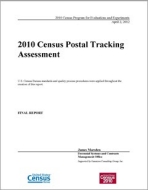2010 Census Postal Tracking Assessment
2010 Census Postal Tracking Assessment
Executive Summary
This document summarizes and evaluates the implementation of United States Postal Service postal tracking technologies (specifically, the Confirm services) during the 2010 Census. The technology provided timely electronic data regarding responses on their way back to the Paper Data Capture Centers as well as on Undeliverable as Addressed mail. The U.S. Census Bureau used this technology to remove responding households and Undeliverable as Addressed mail pieces from the targeted replacement mailing, reducing addressing and mailing costs as well as preventing compliant respondents from receiving multiple forms.
This analysis was conducted by the Decennial Systems and Contracts Management Office. The primary objectives of this evaluation were defined in the planning document “2010 Census Study Plan: 2010 Census Postal Tracking Assessment.” The overall goals are to confirm the reliability of postal tracking data, as compared to the “traditional” Paper Data Capture Center check-in methods and to the 2008 Census Dress Rehearsal conclusions; to confirm the consistency of the data (again, comparing to check-in and the 2008 Census Dress Rehearsal test data); and to evaluate the uses and benefits of the data during the 2010 Census.
Decennial Systems and Contracts Management Office contracted with the initial/replacement questionnaire printer to place postal tracking information on mail pieces via the Intelligent Mail Barcode, and then to retrieve the data from the United States Postal Service scans of these mail pieces. The questionnaire vendor provided the data from the initial mailing to the Decennial Response Integration System program contractor just prior to the compilation of the replacement mailing address list, providing the program with the opportunity to remove addresses from the targeted replacement mailing. Following the 2010 Census, Decennial Systems and Contracts Management Office retrieved all data files from the questionnaire vendor and the Decennial Response Integration System program, created an integrated database, and produced the queries to support this study.
After detailed analysis of the data, we provide evidence for the following conclusions:
- The United States Postal Service postal tracking Confirm services are reliable on a nationwide scale. The data are consistent with the much smaller 2008 Census Dress Rehearsal, showing similar patterns throughout.
- Postal tracking mitigated a major realized risk to the replacement mailing. The Decennial Response Integration System program relied on postal tracking data operationally to create the replacement mail mailing list when its systems encountered technical issues related to the Census Bureau headquarters processing requirements in early April 2010.
- The use of postal tracking data to remove Undeliverable as Addressed mail and responding households from the targeted replacement mailing operation substantially reduced the size of the replacement mailing. This resulted in a major cost savings not only in reduced postage but also in overall operational efficiency.
- The replacement mailing operation reduced Nonresponse Followup workload, and enabled the Census Bureau to match the mail-back response rate from the previous decennial census for the first time in thirty years.
- The targeted replacement mailing was more efficient than the blanket replacement mailing in that it (a) generated fewer Undeliverable as Addressed mail pieces, (b) generated fewer duplicate responses and (c) achieved higher average response rate relative to the size of the outbound mailing.
- The United States Postal Service was able to provide reason codes for non-delivery for a great majority of the Undeliverable as Addressed mail. As expected, vacancy was the most common reason for non-delivery during the 2010 Census.
Lessons learned as well as recent technologies point to future paths to pursue in the use of postal tracking data. Recent oversight reports in particular (by the Office of the Inspector General and the National Academy of Sciences) underscore the potential use of administrative records such as these to provide efficiencies and reduce costs. This is one major use of postal tracking data; others include:
- Reduce the Undeliverable as Addressed rate of mailings by using United States Postal Service tracking services (and/or other records) to identify and remove Undeliverable as Addressed mail pieces prior to subsequent mailings.
- Utilize the United States Postal Service Undeliverable as Addressed reason codes to point to issues with the address file.
- Investigate other uses of the United States Postal Service postal tracking “paradata” for surveys.
- Collaborate with the United States Postal Service on other potential uses of its address status information. As an example, we can possibly determine actual street addresses for areas that use post office boxes, and provide linkages within the Master Address File, potentially eliminating costly Update Leave operations in certain areas.
- Consider using postal tracking services as a replacement for questionnaire sorter check-in at the Paper Data Capture Centers, eliminating an entire, costly operation and resulting in a significant reduction in the size of the Paper Data Capture Centers.
- Consider implementing a full targeted replacement mailing rather than the hybrid targeted and blanket replacement mailing approach, which meant sending a replacement mailing to a great number of households that had already responded or that were Undeliverable as Addressed. Staggered, targeted replacement mailing cutoff dates should also be considered.
- Use United States Postal Service secure destruction services to eliminate the return of 15 million Undeliverable as Addressed questionnaire returns to the Paper Data Capture Centers, resulting in a significant reduction in the size of the Paper Data Capture Centers.
Finally, we note the advantages that the close collaboration between the United States Postal Service and the Census Bureau provided for the 2010 Census. The United States Postal Service/Census Bureau Joint Committee was an important stakeholder communications effort and the various working groups of technical experts were critical to planning and testing. We recommend continued collaboration, preferably concentrating on strategic-level goals and objectives, to achieve enterprise-level cost-savings and efficiencies.
Others in Series
Publication
Publication
Publication




